|
1.
CENTRAL/ WEST AFRICA
Temporary glut in West African log supply
Due to China¡¯s waning demand for logs over the past two weeks, there is an overabundance of log supplies in log
storage parks. As a result, log producers are not able to transport logs to the
already full port storage areas, unless the logs are specifically marked for loading on designated
ships. This is particularly difficult given that shipping availability has been heavily curtailed by
buyers. In an attempt to reverse trends in the log supply, some producers have started lowering prices to tempt Chinese buyers;
however, Chinese buyers seem unlikely to purchase logs until the glut of supply clears.
Although okume is the main species affected by the glut, other species, such as onzabili and okan, which had been
in demand prior to the current situation, have also been negatively affected. To
reduce log supply, West African producers are selling okume to other markets, although
there is fierce negotiation over prices. The markets for India, Europe, and the Middle East continue to be quite
strong, which is helping to keep the overall situation for logs reasonably stable.
It is hoped that the sluggish trends of Chinese buyers are only a temporary setback to the
otherwise ongoing strong market situation for West African logs. Nevertheless, there
are currently no indications of how far down the supply chain the stock congestion extends or how long it will take
to clear. West African producers will be keeping a close eye on how the market develops in the next two months.
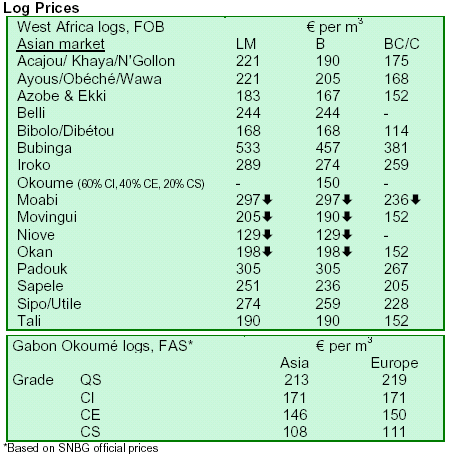
In contrast, demand for sawn lumber has remained very stable and demand for favored species in Europe has
stimulated some quite notable price increases in the past few weeks.

2. GHANA
Ghana¡¯s forest resources diminishing
Ghana¡¯s forestry sector, which includes logging and wood processing operations, constitutes 6% of GDP and
employs about 120,000 people in the formal sector. It also supports the livelihood of about 70% of the rural
population. However, these benefits from forests are at risk as Ghana¡¯s forests reserves are under pressure.
At a recent two-day workshop on forest management planning, Acting Executive Director of the Forestry
Services Division (FSD) of the Forestry Commission (FC), Mr. Matthew Owusu-Abebrese, suggested that
Ghana¡¯s forest reserves were diminishing due to growing demand from the building industry and for educational
facilities. Owusu-Abebrese said the current supply of Ghana¡¯s resources could not meet these demands. He also
noted that the increased rate of harvesting operations had allowed chainsaw operators to destroy the country¡¯s
forests. He urged the government to take a second look at the country¡¯s Temporary Utilization Permit (TUP), which
allowed chainsaw operators to fell trees for community projects, and cautioned that Ghana would cease to have
forest resources in a few years if the nation continued to ignore the rate of forest destruction. He called for the
country to develop stringent measures to monitor activities of forest operators.
At the same workshop, Deputy Minister of Lands, Forestry and Mines, Mr. Andrew Adjei-Yeboah, expressed
concern that forest areas and wildlife in developing countries were declining faster than they were recovering.
This situation, he noted, posed a serious threat to the socio-economic and biological wealth of the countries that
depended on the forest and wildlife resources. The Minister challenged participants at the workshop to
identify practical solutions to existing gaps in forest management, since the Forestry Commission was seeking
alternative means of generating revenue while sustaining forest and wildlife resources.
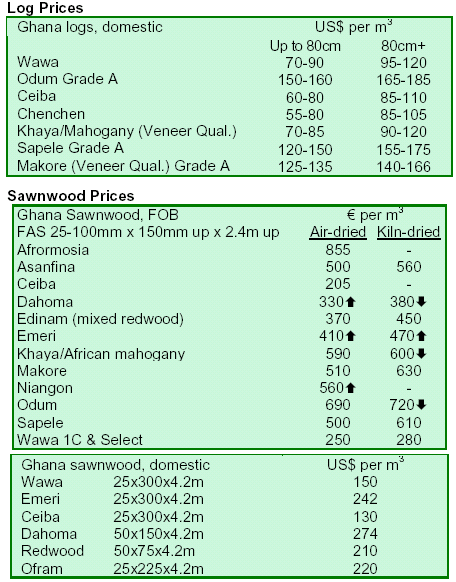
3.
MALAYSIA
Prices for Malaysian timber products reach all time highs
Prices of timber products have reached historical highs. Although some traders believed prices for timber products
would stabilize (see TTM 12:9), others suggest that the prevailing price increase of building materials will cause
timber products to rise by a corresponding 10-30% in the near future. Prices of building materials such as cement
and steel continue to inch upward as projects under the Ninth Malaysia Plan (9MP) commence.
Former minister¡¯s advice paying off
Malaysian furniture manufacturers at one time had been wary of the advice on project development given by
former Minister of Primary Industry, Datuk Seri Lim Keng Yaik. The former minister had often advised Malaysian
furniture manufacturers to invest in product development and innovation to increase their international market share.
The manufacturers that heeded the advice of the former
Minister, however, are now reaping the benefits.
One such manufacturing company, Kimble Furniture Corp. Bhd., has emerged as a strategic business partner
with IKEA of Sweden, which owns and operates more than 250 furniture stores worldwide. Discussions are
underway between the two companies on a EUR200 million contract for bedroom and dining room furniture. If
successful, Kimble will supply IKEA with medium cost pine furniture over a three year period.

4.
INDONESIA
Indonesian traders eye appreciating rupiah
Indonesian timber traders, especially plywood manufacturers, are eyeing the recent appreciation of the
Indonesian rupiah against the US dollar. The rupiah has recently been one of Asia's fastest
rising currencies, as foreign investors buy Indonesian stocks and bonds. Indonesian plywood
manufacturers are watching from the sidelines to ensure they remain competitive with
Malaysian plywood manufacturers. Monetary authorities in Indonesia are of the opinion that the present foreign
exchange rate between the rupiah and US dollar is not detrimental to the country.
Indonesian government signs extradition treaty with Singapore
Making it clear that the government is serious about corruption and money-laundering, the
Indonesian government has signed an extradition treaty with Singapore, the financial center of
Southeast Asia. The island state of Singapore, with its traditional zero tolerance
of graft, is keen to see its reputation as a major global financial center not compromised by trade in illegally
felled timber. The extradition treaty will make it difficult for those involved in the trafficking of illegally felled
timber in Indonesia to operate offshore in Singapore.
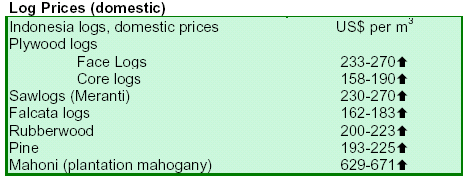

5.
MYANMAR
Prices for teak logs rise as rainy season continues
Due to the shortage of teak logs, prices increased for a second time in the last month. The shortage was due in
part to complex transportation problems on routes from up-country to Yangon. Similar to April¡¯s trends, seasonal
rains had caused the transport problems, which had given way to exceptionally high prices in the tender and sealed
tender in May.

The pyinkado log market remained sluggish while the
market for gurjan logs continued to be firm.

6. BRAZIL
Domestic Brazilian wood product prices stabilize
Wood product prices in Brazilian reals (BRL) remained stable in April compared to March 2007
prices. Due to currency fluctuations, however, prices in US dollars increased by an average of 3.0% as the BRL appreciated
against the US dollar in April 2007.
Lower interest rates expected in June
Due to the appreciating BRL, the Monetary Policy Committee (COPOM) was expected to lower interest rates
by 0.5 percentile points at its next meeting on 5-6 June 2007. The average exchange rate in April 2007 was
BRL1.99 to USD1.00. In addition, inflation was steady in April 2007, and market projections for domestic inflation
to the end of 2007 changed from 3.62% to 3.60%. The prime interest rate as set by the Brazilian Central Bank
(BC) will be kept at 12.50% until it is discussed again at the June COPOM meeting.
Deforestation in Mato Grosso eases by 89% in April
Deforestation rates in Mato Grosso fell 89% in April, compared to April of last year, as assessed by the System
of Deforestation Alert (SAD). Between August 2006 and April 2007, the total statewide forest loss was 2,268km2,
or 37% less than the same period during 2005-2006. Figures for January reflected the lowest deforestation rates
of the period.
Some researchers claimed that the appreciating BRL to the US dollar had directly influenced the falling rates. This
was because the current exchange rate for exports created unfavorable conditions for land clearing necessary for
agribusiness. This was particularly true in the main soy and grain producing and cattle raising regions of the state.
At the same time, government actions against deforestation might have also contributed to the reduced
deforestation rates.
Rural landowners involved with crop production had refrained from making large investments in Mato
Grosso. Consequently, deforestation might ease in the critical burning periods of May, June and
July. In April, no significant deforestation had been observed in rural settlements for agrarian use
and conservation units. The Northwest region of the state had not shown new opened
areas during the month of April, even though the area contains dense forests under high development pressure
and subject to illegal land occupancy, illegal logging and clearcutting for cattle raising.
SEMA Intensifies Control of Log Stocks in Sinop
The Gazeta de Cuiaba reported that the Sinop solid wood industry had been inspected by the State Environment
Secretariat (SEMA). Sinop had more than 200 lumber producers in operation, employing about 2,000 workers.
During controlled visits to Sinop, SEMA checked forest product stocks for sale or storage. The objectives of the
inspections were to investigate and address alleged
irregularities in wood extraction and documentation.
To verify sale and storage, the inspectors undertook checks on whether the companies had an
excess of wood in their accounts or if they had more credits than expected, since the wood was purchased with credit and recorded in SEMA¡¯s consumer accounts. This process also identified companies that had not been registered for a SEMA consumer account, a process that is
mandatory by law and must be renewed on an annual basis. SEMA will continue its inspections,
since the total number of companies inspected is still only at 5% in the region.
Solid wood product exports rose in April
Solid wood product exports, excluding pulp and paper, showed a 14% rise in April 2007 from the
same period in 2006. The total value of exports reached USD352 million in April 2007 compared to USD309 in April 2006. The
data, which was gathered by a government source, might indicate a seasonal effect and would need to be monitored
to determine whether the data revealed a trend.
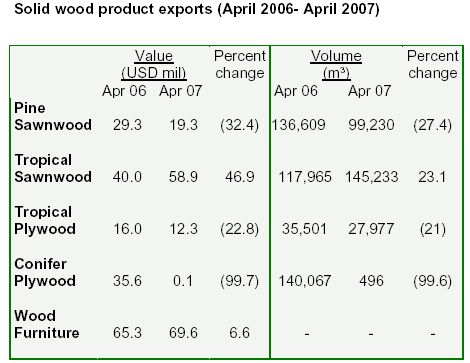
Import tariffs on furniture may increase
The government of Brazil was considering raising the Common External Tariff from 18% to 35%,
according to the publication Infomoney. The proposal, made by the Treasury Department, was
designed to protect domestic producers against a flood of foreign products due to the
depreciating US dollar. The Brazilian Association of Furniture Companies (Abim¨®vel) favors the measure, as
exports of products have fallen between 2005 and 2006. Furniture exports in 2005 reached USD991 million, and
fell to USD945 in 2006. At the same time, imports increased 26%, from USD108 million in 2005 to USD136
million in 2006. Abim¨®vel suggested that furniture prices in the Brazilian market were not likely to incrase, since
consumption of Brazilian furniture reached only BRL13.3 million out of which 2.2% corresponded to imported
furniture products.
Baixo Amazonas receives BRL2 million for furniture district
The municipality of Sao Sebastiao do
Uatuma will have its first furniture district by 2008. According to the Jornal do
Comercio, the Baxio Amazonas received BRL2 million in investments to develop
infrastructure and economic activity in the area. Baxio Amazonas, located about
560km from Manaus, hosts 12 carpentry factories producing mainly wooden and small boats and 14
furniture manufacturers producing wooden beds and tables. The district is expected to contain 25 industrial
sheds, with spaces between 300-450 m2 each. The cluster is expected to generate 65 new jobs and over 15% in sales growth for the participating companies. The construction
of the cluster will be carried out with the support of the Brazilian Servicer of Support to Micro and Small
Companies of the states of Amazonias (SebraeAM), in partnership with the municipal city hall of Sao Sebastiao
do Uatuma and the Amazonian government.
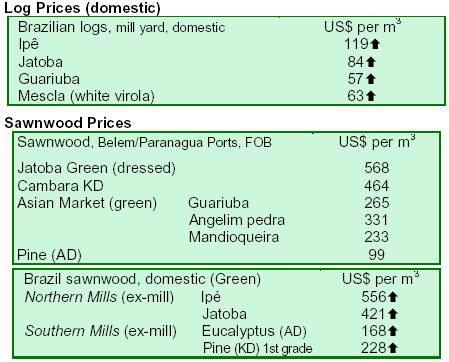
7. PERU
IRENA calls for significant caoba reforestation
The National Institute of Natural Resources (INRENA) is pushing to reforest land with high value caoba at ten times
the current logging rate. INRENA is working with concessionaries, forest entrepreneurs and forest owners to
plant one million caoba saplings in five years, at a rate of 200 saplings a year, to promote forest replanting,
conservation and sustainable forest management. The
initiative will include the regions of Madre de Dios, Ucayali, San Martin, Loreto and Silva Central.
Twenty-four lumber companies in Tahuamanu, Madre de Dios, have already announced their
support of IRENA¡¯s ambitious project to plant more than one million caoba trees.
Concessionaires and forest permit holders will provide funding for the initiative, while INRENA will provide
technical assistance and supervision for the project¡¯s implementation. Project partners will develop nursery
installation, production of saplings and maintenance of the reforested areas.
INRENA has also stipulated that forest concessionaires¡¯ Annual Operative Programs
(POA) should contain plans to replant logged areas. INRENA plans to grant the partners in the scheme a ¡®forest
repossession certificate¡¯ every two years to show how they have complied with the initiative.
INRENA will also be meeting its institutional responsibility to CITES by carrying out the initiative.
Peru¡¯s US FTA may include logging provisions
The Bush Administration and the House Ways and Means Committee are working to establish new procedures to
regulate trade in CITES-listed species (bigleaf mahogany and Spanish cedar) exported from Peru. The International
Wood Products Association (IWPA) reported that the provisions, which would result in changes to the Peruvian
Free Trade Agreement (FTA), could be precedent settingand have impacts on the wood products trade. While the
provisions had yet to obtain Congressional approval, the IWPA noted that even if the new provisions were
approved, it was unclear whether the Peruvian legislature would need to approve the amended
FTA.


8. MEXICO
Mexico organizes workshop on mahogany
Mexico held an international experts workshop for the development of non-detriment findings (NDF) for bigleaf
mahogany (swietenia macrophylla). The workshop, which was held in Canc¨²n, Mexico from 10 to 13 April and
attended by over 46 representatives from 12 countries, was financially supported by the ITTO, the Natural Resources
Defense Council and the Government of Mexico. The
main objective of the workshop was to develop a feasible methodology to formulate NDFs for bigleaf mahogany, to
improve implementation of CITES Appendix II listing and ensure sustainable international trade in mahogany species.
Participants discussed key issues related to the methodology, including: the estimated distribution area of
mahogany; population parameters; and principles, methods and management indicators. The results of the
workshop will be presented at the CITES 14th Conference of the Parties, which will be held in The Hague, the Netherlands, from 3 to 15 June 2007.
9.
Guyana
Government to ramp up detection of illegal logging
The Guyana Forestry Commission will conduct more activities to improve detection and prevention of illegal
logging. The activities were approved and funded by the members of the International
Tropical Timber Council, at its forty-second session in Port Moresby, Papua New Guinea, from 7 to 12 May 2007.
To implement the activities, approximately USD574,000 will be used to develop an integrated and dynamic
monitoring system that will include satellite image analysis and illegal logging indicators. It will also fund the
establishment of a bar code log tracking system to feed into a central database, which will be available nationwide.
These activities will enable regulatory agencies and forest operators to track near real time information on logs.
Additionally, USD361,879 was approved as part of a Phase II ITTO project focused on a reduced
impact logging training programme that would promote best environmental practices. Guayan¡¯s
Forestry Training Center will conduct the training over the next two years. An international
consultant will also help to develop a fire management strategy.

|